When we look at American internment of Americans of Japanese descent, there’s a very strange footnote that nearly everyone tends to overlook: it’s really all about racism in California, especially Stanford.
Take for easy example that in 1941 there were 150,000 Americans of Japanese descent living in Hawaii (compared with 130,000 on the mainland). Although the mainland population didn’t reach even 1% of the West Coast, these numbers in Hawaii translate to up to 30% of the population. Yet they weren’t all rounded up and seen as a threat. Even more to the point Hawaii from the very start of WWII was considered a war zone of strategic importance.
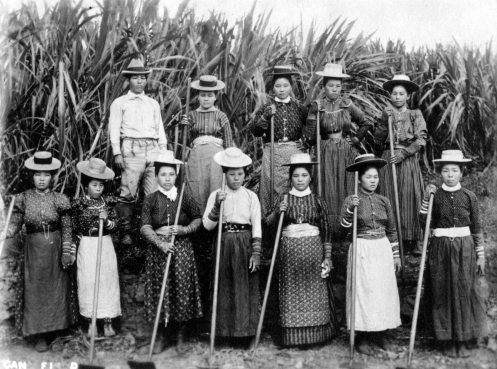
Thus, when looking at the California politicians in this light, Americans should see that internment was specifically about California using WWII as an excuse to legislate racism in an overtly immoral form of economic expropriation by whites. It had absolutely nothing to do with security, nothing to do with war even, and everything to do with a man named Leland Stanford.
I’ve written before how Stanford pushed virulent racism as Governor of California (1862–1863). Others have written about his record of genocide:
Most Californians are unaware that in the second half of the 19th century their state sponsored and funded a campaign to exterminate its Indigenous population — a mass atrocity known under contemporary international law as genocide.
Racism and genocide in California was clearly very bad within the state lines, yet there also are examples of how it fed directly into influencing and forcing racism wider across American federal policy:
In May 1912, President Woodrow Wilson wrote to a California backer: “In the matter of Chinese and Japanese coolie immigration I stand for the national policy of exclusion (or restricted immigration)…We cannot make a homogeneous population out of people who do not blend with the Caucasian race…Oriental coolieism will give us another race problem to solve, and surely we have had our lesson.”
The President of the US thus showed himself to be a racist in violent agreement, doubling-down on a particular Californian manifestation of racism that had bloomed under Stanford’s high-profile hatred of Asians.
On May 3, 1913, California enacted the Alien Land Law, barring Asian immigrants from owning land. California tightened the law further in 1920 and 1923, barring the leasing of land and land ownership by American-born children of Asian immigrant parents or by corporations controlled by Asian immigrants. These laws were supported by the California press, as well as the Hollywood Association, Japanese and Korean (later Asiatic) Exclusion League and the Anti-Jap Laundry League (both founded by labor unions).
What’s that you say?
How does such anti-Asian action in 1913 and the later overt white nationalism of America link back to Stanford who was in power many years earlier?
The Atlantic paints a picture for us in the years following Stanford’s infamous “white nationalist” speech as Governor:
With help from the journalist Knute Berger, I’ve uncovered more than a dozen attacks attributed to the Klan in California from 1868 to 1870, as well as a smaller number in Utah and Oregon. That figure is minuscule compared with what the former Confederate states endured in these years. Nonetheless, each of these western attacks left victims and sowed terror. And collectively, they challenge common assumptions about America’s long history of white-supremacist violence.
Indeed, Stanford seems front-and-center to bolstering the anti-Asian hate groups and domestic terrorism that became normalized in California.
Spurred by popular Sinophobia, California lawmakers campaigned against the two signal measures of the Reconstruction era, the Fourteenth and Fifteenth Amendments. […] They falsely claimed that the Fifteenth Amendment would extend the vote to all Chinese, when in fact Asian immigrants were barred from citizenship and suffrage. […] California became the lone free state to reject both amendments outright.
Let’s look back at the 1860s language of Stanford again, just to be clear.
California Governor Leland Stanford, then CEO of the Central Pacific Railroad, had harsh words about the Chinese… “To my mind it is clear, that the settlement among us of an inferior race is to be discouraged by every legitimate means. Asia, with her numberless millions, sends to our shores the dregs of her population.”
“Anti-coolie clubs” were organized immediately following Stanford’s speech in 1862, brewing hate and exclusion leading directly into a Klan violence explosion of 1867.
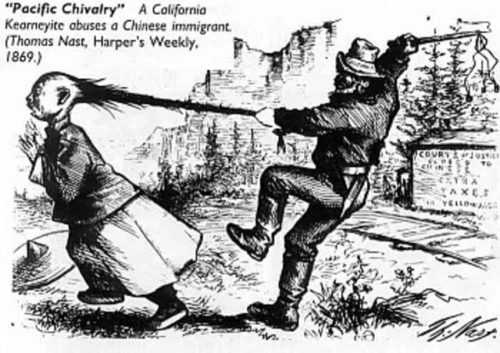
In other words, California took an American legacy of slavery and hate targeting blacks, and expanded it to Asians.
John Carr, who arrived in 1850, observed in his memoir Pioneer Days in California, that “From 1849 to 1861, the State of California was…as intensely Southern as Mississippi or any of the other fire-eating States.”
The climate of anti-Asian hate at the hands of Stanford quickly spread from California into a national partisan issue.
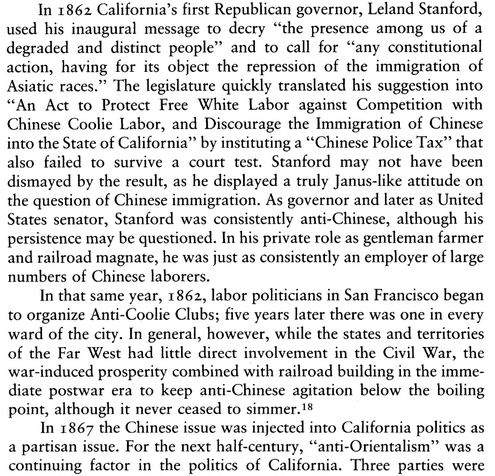
Do you see how Stanford was into railroads and agriculture, both heavily dependent on Chinese immigration, yet he also was a leader in denying Asian Americans any prosperity from their hard work for him?
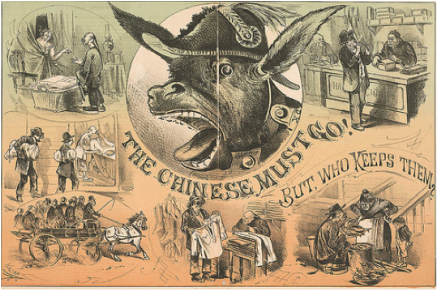
That hypocrisy was a form of racist servitude, similar to how Blacks technically were emancipated yet actively denied freedoms or rights. This matters a lot in American history because we see California’s “leaders” from its start — particularly Stanford who personally profited from hate — building racism into their foundations of political power.
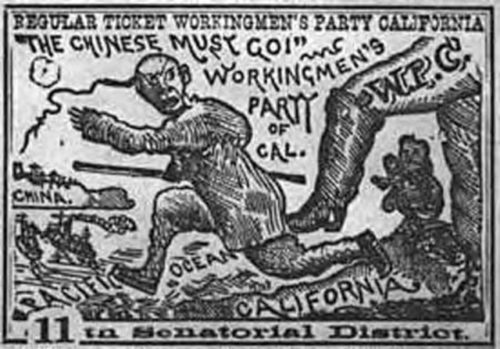
It’s a legacy of Stanford that thus leads President Wilson even before WWI to say he is aiming for a national policy of exclusion, which by 1915 became known as the “America First” platform to revive the KKK (more lynchings of blacks under Wilson in 1915 than all the years of the prior decade combined).
This is all rarely ever discussed. Comment below if you disagree. I mean it’s far more likely to hear people discuss America’s disgraceful internment of Japanese Americans during WWII. These internment camps seem for most Americans to be the most recognizable frame of reference, any time anti-Asian history becomes a discussion topic.
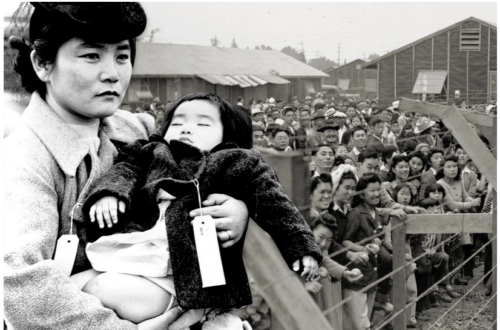
It turns out these anti-Asian concentration camps were a logical conclusion of Stanford’s high-profile 1862 platform as well; a result of America failing to fight back against a peculiar Californian strain of violent racism.
Any rational person for example might seek for explanations why Japanese could be so callously pushed into camps by America, yet Germans and Italians were not.
Or perhaps more significantly, people should ask why German Nazi soldiers captured and held as prisoners of war were literally treated as “allies” and helpful hands around the American farmland… while at the same time loyal and patriotic Japanese-Americans were taken off their farms and put into concentration camps.
The answer to this completely different treatment is simple: Stanford (or really the racism that Stanford practiced and encouraged as CEO, Governor and US Senator).
An infamously ruthless and immoral business man had promoted anti-Asian hate movements in the West from his seat in local government all the way to national policy.
Stanford in the 1860s inscrutably linked Californian white-insecurity issues to federal policy, as a means of enabling self-interested white businessmen to steal land from Asian Americans.
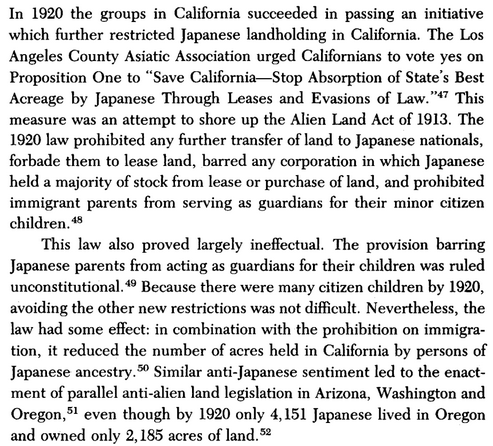
Internment of the Japanese thus was lobbied by California businessmen into federal government, and NOT the other way around as is often told incorrectly.
It was a repeat of tragic history, a long time strategy, where Californian industry set out to abuse segments of workers, deny prosperity and steal land/assets because of racism.
From a competitive standpoint you can imagine the glee of white property owners who get to seize assets of their Asian American neighbors.
On the other hand, when Black Americans were relocated into vacant Japanese American homes in San Francisco (to work in the Navy yards and help with WWII war efforts) there allegedly was a lot of unease and discomfort, which led these Black Americans to move up/out and build their own houses instead (not to mention they were targeted by “Urban Renewal” forcing them out).
Kind of amazing to think about just how few Asian Americans had achieved property rights and prosperity against ruthlessly racist government-sanctioned attacks, yet there remained no tolerance and ongoing threats to force the numbers to zero.
The federal government in WWII fell into this trap, enabling false “fear” of the entirely self-interested California racist tycoons.
However, WWII also saw something different unfold. The federal government slowly turned itself around on California policy and by 1945 started to shake off some of Wilson and Stanford’s troubled legacy of racism (thanks to Roosevelt).
A Japanese American may be no more Japanese than a German-American is German, or an Italian-American is Italian, or of any other national background. All of these people, including the Japanese Americans, have men who are fighting today for the preservation of the democratic way of life and the ideas around which our nation was built.
We have no common race in this country, but we have an ideal to which all of us are loyal: we cannot progress if we look down upon any group of people amongst us because of race or religion.
In 1948 the federal government was in opposition to California racism. However significant damage to America had been done nonetheless by those going along with Stanford instead of standing against him.
Stanford’s long legacy of hate, exclusion and internment camps (not to mention genocide) thus present essential reading that helps illuminate America’s long struggle to move aware from horrific consequences of systemic racism.
At the end of the day we have to ask ourselves in all seriousness, why is Stanford still a name people today want to associate themselves with?
Update: In comparison to Stanford’s overt racism and fear-mongering of the 1860s, consider at that exact time Lincoln’s 1864 “Act to Encourage Immigration“.
Indeed, Lincoln wasn’t a man ahead of his time, he was highly logical and empathetic, unlike the extremely regressive racism and xenophobia of Stanford.
The U.S. is at its best when it welcomes talent from around the world and gives people the tools to succeed and thrive here.
Stanford, like a Wilson or Trump, was the U.S. at its worst.